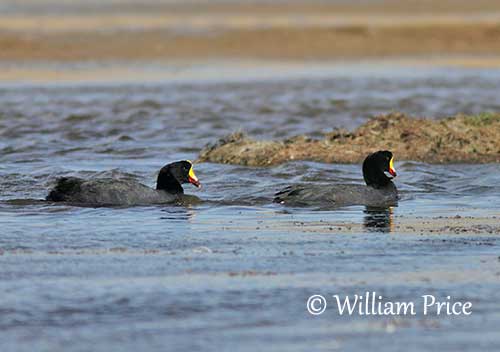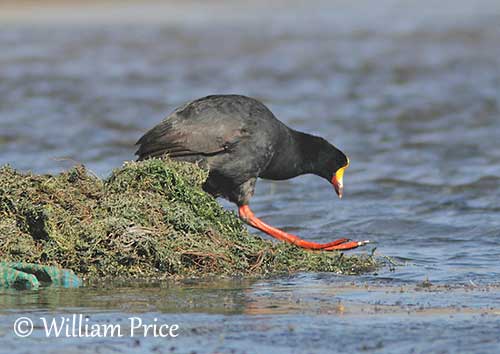
Fr: Foulque géante
Ang: Giant Coot
All: Riesenbläßhuhn
Esp: Focha Gigante
Ita: Folaga gigante
Nd: Reuzenkoet
Sd: jättesothöna
Photographers:
Roger Ahlman
Pbase Galleries Peru and Ecuador
Ken Havard
My Bird Gallery & Flickr gallery 1 & Flickr gallery 2
Patrick Ingremeau
TAMANDUA
William Price
PBase-tereksandpiper & Flickr William Price
Texte de Nicole Bouglouan
Sources :
HANDBOOK OF THE BIRDS OF THE WORLD Vol 3 by Josep del Hoyo-Andrew Elliott-Jordi Sargatal - Lynx Edicions - ISBN : 8487334202
L’ENCYCLOPEDIE MONDIALE DES OISEAUX - Dr Christopher M. Perrins - BORDAS - ISBN: 2040185607
BIRDS OF PERU by Thomas S. Schulenberg, Douglas F. Stotz, Daniel F. Lane, John P. O’Neill, Theodore A. Parker III – Princeton University Press 2007– ISBN: 978-0-691-13023-1
SORA – Notes on the Giant Coot by ROBERT W. McFARLANE
Neotropical Birds – Cornell Lab of Ornithology
THE AVIANWEB - Beauty of Birds (Sibylle Faye)
Wikipedia, the free encyclopaedia
Giant Coot
Fulica gigantea
Gruiformes Order – Rallidae Family
INTRODUCTION:
The Giant Coot is included in the family Rallidae, and is found in South America. It is one of the largest species of this family, alongside the flightless Takahe of New Zealand. The adult is considered flightless but the less heavy immature can flies easily.
This species is highly territorial and during the breeding season that may last all year round, competition and fighting for nest material are common.
The Giant Coot is usually found at high elevations, and may occur up to 6500 metres where it frequents mountain lakes. Its population appears currently stable.
DESCRIPTION OF THE BIRD:
Biometrics:
Length: 48-59 cm
Weight: 2000-2500 g
The Giant Coot adult has dark slaty plumage overall, with blacker head and neck. We can see some white on outer undertail-coverts.
The body is heavy but the head is relatively small, with distinctly concave forehead.
Bill and frontal shield are red, white and yellow. The bill itself is mostly red at base of lower mandible. It is deep red with reduced whitish tip. The ridge is white whereas sides and shield are yellow. There are two conspicuous feathered knobs above the frontal shield.
The eyes are deep red. The strong legs and feet are dark red.
Male and female are similar.

The juvenile is dark grey with white foreneck and head sides. The bare parts are dark.
The immature is duller than adults overall, with mostly dark grey breast and belly. Bill, legs and feet are duller too, usually pale greyish red. It is less heavy than adults and can fly easily.
RANGE:
The Giant Coot is found in S Peru and W Bolivia to NE Chile and extreme NW Argentina (Catamarca).
HABITAT:
The Giant Coot is found in the altiplano, the widest part of the Andes, where it frequents ponds and lakes. It nests on huge platforms and requires shallow waters with weeds to build it.
This species usually occurs between 3,600 and 5,000 metres of elevation, but it has been recorded up to 6,500 metres.
CALLS AND SONGS: SOUNDS BY XENO-CANTO
The Giant Coot is loud and vocal. During interactions and competition for nesting material, they produce purring and squawking sounds towards each other.
The male utters gobbling “hou hou hou hou” and low “horr” sounds. The female gives crackling “chee-jrrrh”. These sounds may sometimes become softer “hi-hirr hirr” when she is with the male.
Most Fulica species give short, aggressive calls such as “pit”, “hic” or “pssi”.
BEHAVIOUR IN THE WILD:
The Giant Coot has vegetarian diet. It feeds mainly on aquatic vegetation and some algae. It also grazes on the shore where it feeds on grass.
But it forages mainly on water, sweeping the surface from side to side with the bill and seizing some grasses. It may occasionally dive and upend like a duck.
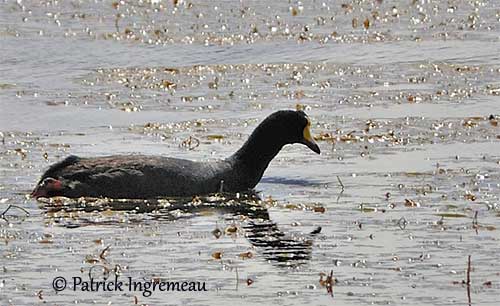
During the breeding season that may last all year round, male and female defend strongly the territory around the nest. This area extends from the nesting site to the shoreline, and often includes a small area of open water towards the centre of the lake.
The Giant Coot is monogamous with long-term pair-bonds, and is territorial all year round. They can be very aggressive towards intruders, including conspecifics. The fighting behaviour includes splattering attack during which the owner of the territory runs over the water in aggressive posture with strong wingbeats, while chasing the intruder. However, the attacker often brakes sharply by closing its wings, raising its body and treading water, in order to avoid violent confrontation.
The Giant Coot can breed throughout the year in the Andes, and it builds a huge, permanent nest.
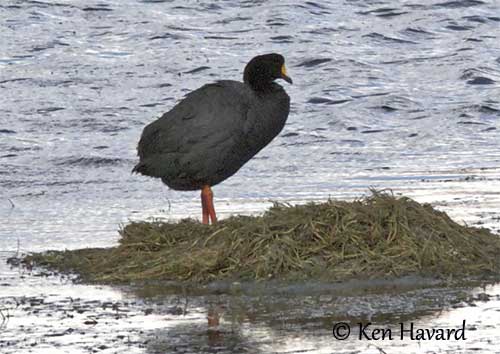
The Giant Coot does not move in winter. The adults remain on the territory for life. When the mountain lakes freeze, they gather in small groups around volcanic springs scattered throughout the region. There, they can find ice-free pools and sufficient food resources until the next spring. They also walk to larger, ice-free lakes. They may sometimes move to lower elevations.
The Giant Coot adult is considered flightless, but the less heavy immatures disperse widely by flying at night.
REPRODUCTION OF THIS SPECIES:
The Giant Coot breeds all year round, with peak during the austral winter in June-July. It may produce a second clutch between November and February.
This species builds a large nest platform, a bulky, non-floating structure made with aquatic vegetation and placed in open water, at variable distance from the shore. Such nest is very conspicuous and may reach three metres and more in diameter. The height above the water is about 20-25 centimetres. The deep cup prevents observation of eggs and chicks.
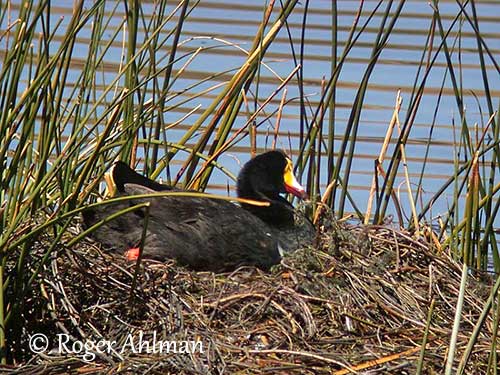
The nest is not a floating structure but a huge platform that rests directly on the bottom. It is usually built on lake or pond without emergent vegetation. It is placed in deep water to reduce predation from terrestrial animals. Both adults build it, and they continuously add fresh vegetation on the rim.
The female lays 3-7, often 5 large eggs, and both adults share the incubation that should require 25 days, but more information is needed. The chicks have sooty black down with browner underparts and typical, bare, pink skin patch on the crown. The bill is pink with yellow tip and deep red base. They are fed by both parents during two months.
The chicks spend most of their time in the nest, in order to shelter against the strong winds blowing on the lakes. They feed on fresh vegetation taken from the rim of the nest, but the adults bring them pieces of weeds and amphipods.
PROTECTION / THREATS / STATUS:
The Giant Coot is fairly scarce throughout the range, but there are some large populations in some areas, and especially in Lauca National Park in N Chile where a population of up to 12,000 individuals is living.
The global population is currently stable and even increasing in Chile and Peru, due to control of use of fire-arms.
The Giant Coot is currently evaluated as least Concern.
